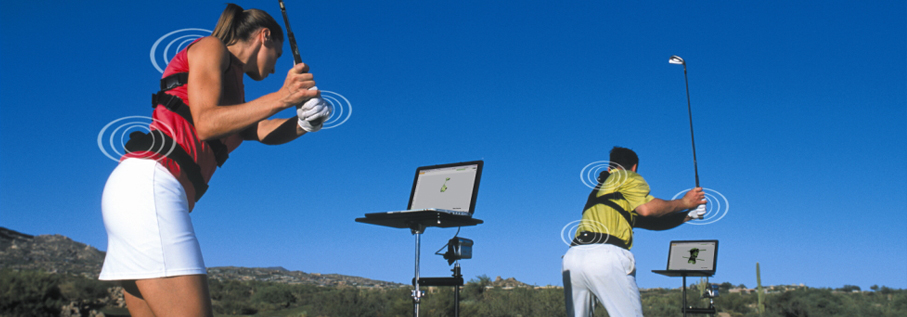
60 Minute K Vest Lesson $120
K-VEST is an all in one capture, analysis and training solution. This 3D software allows us to measure swing efficiency and compare this 3D motion to the world's top PGA, LPGA and champion tour players.This real time training experience improves swing faults in less time.
Kinematic Sequence
If there's one thing that I have learned over the past 15 years, it is that no two golfers have the same golf swing. But for some reason every time I meet a golfer it seems like all they want to do is visually compare their golf swing to another golfer. This type of mentality never made sense to me. Why would I want to compare myself to another golfer who probably doesn't have the same physical structure or physical capabilities as me, and therefore, could never feel what I feel when I swing the golf club. The problem comes from us not having a better way to evaluate the golf swing. What we should do is figure out if our golf swing is efficient or inefficient and then make corrective changes based on that information. Unfortunately, we have never been able to measure efficiency of the golf swing, only how it looks or its style, until now.
Haven't you ever wondered how someone like Jim Furyk won the U.S. Open with that golf swing? Or how players like Raymond Floyd or even John Daly have had such successful careers with such unorthodox golf swings. Fortunately, with the aid of new 3-D motion capture systems, researchers have been able to identify the true measurement of a good golf swing. The answer is not how close your swing looks like Ernie Els or Tiger Woods on a video camera, the answer is how efficient your swing measures compared to the best players in the world. In other words, there are a lot of ugly golf swings on the PGA Tour, but they all seem to get the job done. The question you should be asking yourself is how can I make my golf swing get the job done?
Using data collected from 3-D motion analysis systems, we are now looking at how golfers generate speed and transfer this speed or energy throughout their bodies. We have found a certain sequence or signature of how they get this speed to the club head. We call this the “Kinematic Sequence”. The amazing thing is that all great ball strikers have the same kinematic sequence or the same signature of generating speed and transferring speed throughout their body. That means if you compare Ernie Els kinematic sequence to Jim Furyk's kinematic sequence it's hard to show a difference. That is a bold statement since there is an obvious difference on a video camera between these two players. All great ball strikers begin by generating speed from their lower body and transferring this speed through their torso, into their arms, and then into the club. What style they use to complete this signature is completely unique to each player.
So the key points to know about the kinematic sequence are the following:
1) There is an identical sequence of speed or energy generation for all great ball strikers. That sequence is: lower body first (red line on the graph above), trunk or torso second (green line), arms third (blue line), and the club last (maroon line). This sequence occurs during the downswing.
2) Each segment of the body builds on the previous segment, increasing speed up the chain. (Red is less than green, which is less than blue, which is less than maroon).
3) Each segment of the chain slows down once the next segment begins to accelerate. This is due to the distal segment pushing off the proximal segment. Imagine a child jumping off their dad's shoulders in a swimming pool. As the child jumps, the force rapidly slows down the dad's energy. This causes a sequential deceleration or stabilization of the segments.
4) Unorthodox styles may have no effect on your ability to generate a good kinematic sequence. In other words, Jim Furyk and Davis Love can have the same kinematic sequence. With that said, there are three things that have been shown to create efficiency or kinematic sequence breakdowns:
1) Improper swing mechanics.
2) Physical limitations
3) Improperly fit equipment.
During the downswing in golf all body segments must accelerate and decelerate in the correct sequence with precise and specific timing so that the club arrives at impact accurately and with maximal speed. The correct sequence of motion for the major segments is: pelvis, trunk, arms and finally club. This motion must occur sequentially with each peak speed being faster but later than the previous one. This sequence reflects an efficient transfer of energy across each joint and facilitates an increase in energy from the proximal segment to the distal one. The muscles of each joint produce this increase in energy. On the other hand, if the timing of energy transfer is wrong, energy can be dissipated instead of added and as a result, speed will be lost. Also if one body part has to compensate because another is not doing its job, then injury may result.
During the forward swing, the larger, core segments such as the pelvis and trunk, move slower with the speed building as the energy progresses to the smaller distal segments such as the arms and club. Note that the pelvis does not continue accelerating through impact, but decelerates before impact. Whether the deceleration of the previous segment is caused by the acceleration of the next segment or, whether the previous segment is actively decelerated by muscular action is still a matter of debate within the biomechanics community. Further research is needed on this point.
In order to quantify the differences in the kinematic sequence between golfers we compare specific values from the segmental rotational speed curves. For example, we can look at the:
1) Maximum rotation speeds of each segment.
2) Progressive speed gains between segments.
3) Sequence of maximum speeds.
4) Timing of maximum speeds with respect to impact.
5) Average accelerations and decelerations before impact.
Using these parameters we can quickly tell what segment of the body is in error.
So in summary, and looking at the graph above, between "T (top of the swing)" and "I (impact)" the kinematic sequence proceeds as follows:
Pelvis (red) accelerates and peaks at a lower speed than the other segments, and then decelerates rapidly. Trunk (green) accelerates to a higher speed than the pelvis, and then decelerates rapidly. Arms (blue) accelerate to a higher speed than the trunk, and then decelerate rapidly. Club (brown) continues accelerating reaching maximum speed at or very near impact. Notice also that each segment speed peaks slightly later than the previous highest speed.
